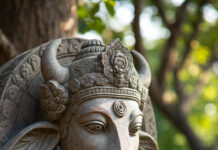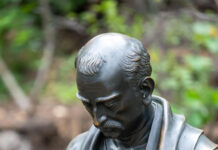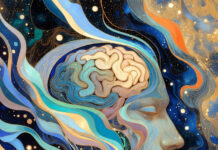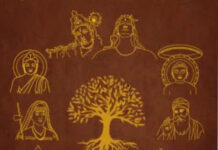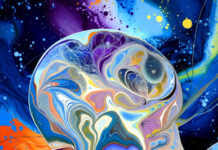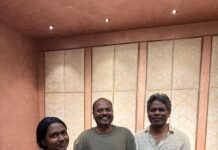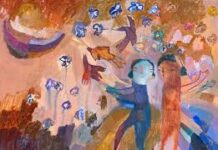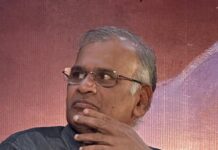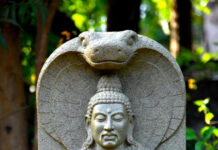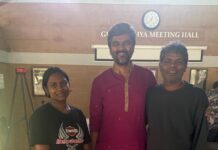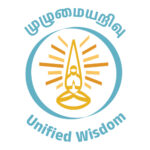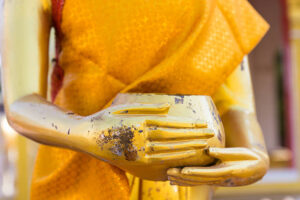
This happened in 1995. Guru Nitya had arrived to teach a class. He had brought a feather with him. A large, white feather. His face held its usual sharpness.
It was Guru’s habit to sit in deep meditation for some time before every class. He would always enter at exactly the right moment and take his seat. Sometimes, he would remain in a meditative state even after he had sat down. On rare occassions, the meditative state would continue for the entirety of the class, at the end of which he would get up and leave. It would seem as if his face was imbued at once with an extraordinary vitality and a statuesque timelessness.
Usually, the audience would settle down much before his arrival. The class would be so quiet that one could hear Nitya’s footsteps and breathing even as he arrived. On that day, though, people were still streaming in after he had come. Someone signalled to a fellow student to come sit nearby. Another person stepped out, spoke to someone who was outside, talking, and led them into class.
Nitya was waiting for them to settle down, with feather in hand. One of the students got up, picked up the bag he’d left beside someone else and repositioned it by his side. Another person fetched a cushion to sit on from a corner of the room. Someon gestured to a neighbour to pass a blanket.
Nitya smiled. He extended the feather in my direction. Clueless as to why he was giving it to me, I received the feather.
‘Let’s sing deivadasagam,’ Nitya said to the class.
We sang the prayer composed by Narayana Guru, a prayer which all of us knew. Then, Nitya offered a simple commentary on it. The prayer meet ended. Guru left and went back to his room.
Not knowing what to do with the feather, I placed it as a bookmark in Nataraja Guru’s Wisdom: The Absolute is Adorable, a book I was reading at the time.
I met Nitya again, at eleven in the morning that day. Those were the days when he was writing a commentary on the Brihadaranyaka Upanishad. The session at eleven had been convened for the purpose. Four students would make notes while Nitya held forth on the subject. It was a kind of class in itself. But there would be no more than four students. Nitya was in his room. Ramakrishnan was getting ready for the class, in the glass enclosure adjacent to the room. I went in.
Seeing me, Nitya smiled and said, ‘That feather belongs to an extraordinary bird…The white owl. It had paid us a visit during the night.’
‘Yes,’ I said.
‘And, it seems to have left us a message,’ he added, smiling to himself joyfully. That childlike quality of his, I knew quite well. In moments such as those, I would feel I was older than him. I smiled, too.
‘What did you do with the feather?’ he asked.
‘I kept it inside Nataraja Guru’s book.’
‘Where exactly?’
‘At the chapter about Samyak Darshan.’
‘Well done,’ he said, and smiled again.
‘An owl can turn its head and look in all six directions. It can merge all six perspectives and see it as a single picture.’
‘I sometimes think that the owl has a permanent expression of awe on its face.’
‘Awe is the first sublime feeling…it is the wellspring of all questions. Poets and men of wisdom are always in a state of limitless wonder. What, why, how…they wonder without end. A child’s abiding state of mind is one of awe…its brow is perenially lifted. When this wonder runs out, people become ordinary men and women, and adjust to a quotidian life. Rishis and kavis are those in whom wonder is never extinguished.’
Nitya went on. ‘I have seen African priests wear feathers in their hair. It’s possible that priests in ancient times donned feathers as well. Later, kings donned them. Then, the common people too wore feathers in their caps. A feather in the cap! It’s a type of victory. All victory is the surpassing of one’s highest limit…
‘How did feathers become symbols of victory? What would the man who wore it for the very first time have thought? Give a feather to a small child…it will hold it up right away and wave it around…it will stick the feather in its hair. A feather is one thing that birds have, but men don’t. Man has always nurtured the dream of flight. He has always longed for it. There’s no man who hasn’t flown in his dreams. There’s no child that hasn’t tried to fly…’ said Nitya.
‘I broke my chin while trying to lift off with two winnows for wings…and ended up with four stitches…I still have that scar.’
‘And I broke my hand,’ Nitya said, laughing. ‘Most writers and poets will have such experiences to sharel…How besotted man is with the feather. The Semitic tradition imagines its gods and angels with wings. All poets keep writing about birds. Look closely, and you’ll see that what they write about is the feather, not the bird.’
I thought about the birds that feature in Devadevan’s poems.
‘The wing belongs in the sky. It swims and rejoices in the ever-growing luminescence of endlessness. It may come down to earth, but it does not belong here,’ said Nitya. ‘What a man who decorates his head with a feather knows in his heart and conveys to others, is this: I am human, but that is not all I am. A small part of me is a bird. Here I am, wearing on my head the aspect of a bird. My body might not take wing, but my inner being may well fly…
‘It is an announcement, a way of saying “I am a bird!”’ said Nitya. ‘A declaration that the sky is in me. Priests and kings made such declarations…I, too, wanted to wear a feather in my head.
Dr. Thampan (Swami Tanmaya in due course) approached Nitya. Nitya got up.
‘Was this what you had planned to share this morning?’ I asked.
‘No. It’s what came to my mind just now. What I had planned on speaking in class began from that feather…’
‘You could have talked about it.’
‘When I talk, I should address everyone. I have to. But there are two kinds of talks. One, is a kind that makes sense in this world, in the present moment. Utilitarian talks. That is what must use with the lay person. Things that go beyond it, one can only discuss with those who are capable of going beyond it, as well. The defining quality of people capable of such transcendence is only one thing. They are always attentive. That is what the Upanishads call jagrat. Uttishta jagrat. Uttishta means to awaken. At some point, the inner self awakens and attains a state of astoundment. After that, the awakening lasts forever. Regardless of the situation or the environment they are in, such people can channel their full attention at will. This quality is often compared to a cat’s ear. When a cat sleeps, its ears keept twitching vigilantly. That alertness is a fundamental requirement for learning. It is only with those who have so awakened can one talk of subtleties. For, the subtle isn’t something than can be explained. It has to be conveyed. The speaker can only offer a suggestion. It is the listener who builds on it. For that to happen, his inner self should have flowered fully…’
As Nitya walked to the writing room holding Thampan’s shoulder, he turned around and uttered a line that I recall with great astoundment, even today. ‘How does one teach true-wisdom, that which we call mei-gnana? I’ll give you a metaphor. It is a gold coin dropped in a golden alms bowl.’
Translated by Priyamvada Ramkumar
(Translated from the original Tamil essay, Thangath Thiruvodu, by Jeyamohan https://www.jeyamohan.in/199630/)
